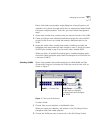
42 C
HAPTER
4: A
DVANCED
M
ANAGEMENT
T
ASKS
interface modules directly; you configure them through the switch
fabric module.
To create VLANs in the CoreBuilder 9000 environment, you configure
these components:
■
Layer 2 and Layer 3 switching modules
— You connect to these
individually through the EME (Enterprise Management Engine) and
configure the following ports based on your VLAN configuration:
■
Front-panel ports
— Typically connect external devices to the
switching module. The number of front-panel ports varies
according to the model of switching module (for example, one
model 10/100TX Layer 2 Switching Module offers 20 front-panel
ports).
■
Backplane port
— Connects the switching module to the 24-port
Gigabit Ethernet Switch Fabric Module. The Layer 3 switching
modules have only one backplane port. Layer 2 switching modules
have two backplane ports; you configure the lower-numbered
backplane port, which is enabled by default. (The higher-numbered
backplane port is available as a trunk port only.) Example: If you are
logged into a 20-port Layer 2 interface module via the EME and
configure front-panel ports as members of a port-based VLAN that
spans modules, you configure port 21 (the lowered-numbered
backplane port) as part of the VLAN. When you have multiple
VLANs, this module backplane port must be tagged for all but one
of the VLANs. (For one VLAN, such as the default VLAN, the
backplane port can be untagged, but for the other VLANs, the
backplane port must be tagged.)
■
Switch Fabric
Module
—The central backplane for the system. To
ensure cross-module communication (for example, within VLANs that
span modules), you must configure the switch fabric module to
include the VLANs that you configure on your switching modules. You
configure the switch fabric module’s Gigabit Ethernet ports (24 ports
in a 16-slot chassis module) in accordance with:
■
The chassis slot placement and VLAN configuration of your
individual switching modules (configured through the EME). For a
switching module in slot 1, you configure switch fabric module
port 1.
■
The chassis slot placement of your GEN interface modules. To
create VLANs for these non-local switching modules, you configure
their VLANs by configuring the corresponding switch fabric module


















